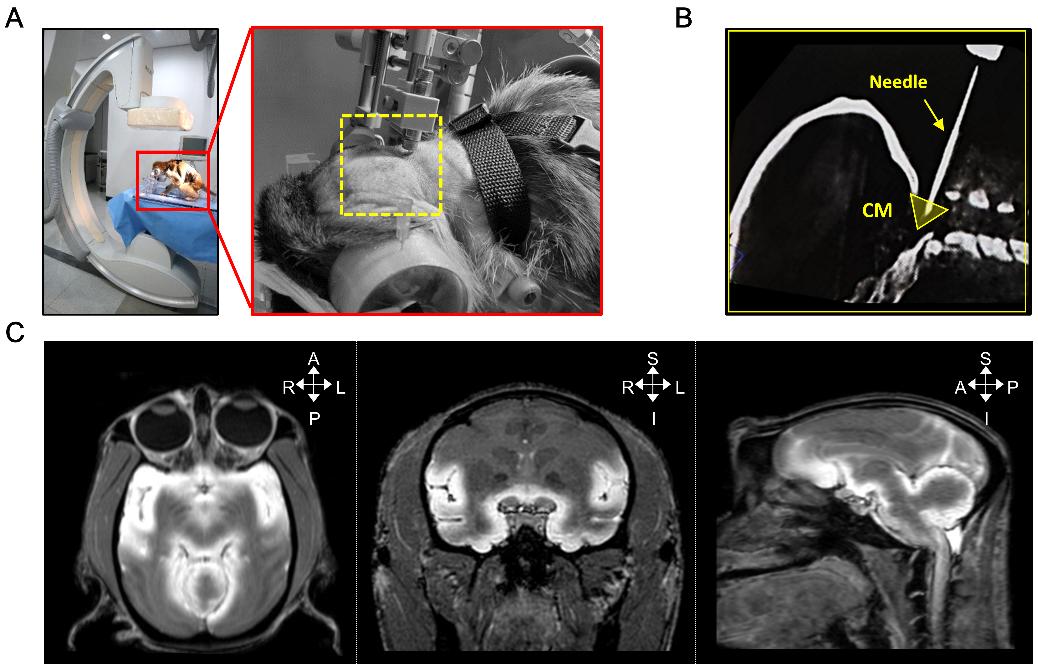Articles
Article Tools
Stats or Metrics
Article
Original Article
Exp Neurobiol 2022; 31(6): 409-418
Published online December 31, 2022
https://doi.org/10.5607/en22027
© The Korean Society for Brain and Neural Sciences
XperCT-guided Intra-cisterna Magna Injection of Streptozotocin for Establishing an Alzheimer’s Disease Model Using the Cynomolgus Monkey (Macaca fascicularis )
Junghyung Park1†, Jinyoung Won1†, Chang-Yeop Jeon1, Kyung Seob Lim2, Won Seok Choi1, Sung-hyun Park1, Jincheol Seo1, Jiyeon Cho1, Jung Bae Seong1, Hyeon-Gu Yeo1,3, Keonwoo Kim1,4, Yu Gyeong Kim1,3, Minji Kim1,5, Kyung Sik Yi6 and Youngjeon Lee1,3*
1National Primate Research Center, Korea Research Institute of Bioscience and Biotechnology (KRIBB), Cheongju 28116, 2Futuristic Animal Resource and Research Center, Korea Research Institute of Bioscience and Biotechnology (KRIBB), Cheongju 28116, 3KRIBB School of Bioscience, University of Science and Technology (UST), Daejeon 34113, 4School of Life Sciences, BK21 Plus KNU Creative BioResearch Group, Kyungpook National University, Daegu 41566, 5Department of Bio and Brain Engineering, Korea Advanced Institute of Science and Technology (KAIST), Daejeon 34141, 6Department of Radiology, Chungbuk National University Hospital, Cheongju 28644, Korea
Correspondence to: *To whom correspondence should be addressed.
TEL: 82-43-240-6316, FAX: 82-43-240-6309
e-mail: neurosci@kribb.re.kr
†These authors contributed equally to this article.
This is an Open Access article distributed under the terms of the Creative Commons Attribution Non-Commercial License (http://creativecommons.org/licenses/by-nc/4.0) which permits unrestricted non-commercial use, distribution, and reproduction in any medium, provided the original work is properly cited.
Abstract
Till date, researchers have been developing animal models of Alzheimer’s disease (AD) in various species to understand the pathological characterization and molecular mechanistic pathways associated with this condition in humans to identify potential therapeutic treatments. A widely recognized AD model that mimics the pathology of human AD involves the intracerebroventricular (ICV) injection with streptozotocin (STZ). However, ICV injection as an invasive approach has several limitations related to complicated surgical procedures. Therefore, in the present study, we created a customized stereotaxic frame using the XperCT-guided system for injecting STZ in cynomolgus monkeys, aiming to establish an AD model. The anatomical structures surrounding the cisterna magna (CM) were confirmed using CT/MRI fusion images of monkey brain with XperCT, the c-arm cone beam computed tomography. XperCT was used to determine the appropriate direction in which the needle tip should be inserted within the CM region. Cerebrospinal fluid (CSF) was collected to confirm the accurate target site when STZ was injected into the CM. Cynomolgus monkeys were administered STZ dissolved in artificial CSF once every week for 4 weeks via intracisterna magna (ICM) injection using XperCT-guided stereotactic system. The molecular mechanisms underlying the progression of STZ-induced AD pathology were analyzed two weeks after the final injection. The monkeys subjected to XperCT-based STZ injection via the ICM route showed features of AD pathology, including markedly enhanced neuronal loss, synaptic impairment, and tau phosphorylation in the hippocampus. These findings suggest a new approach for the construction of neurodegenerative disease models and development of therapeutic strategies.
Graphical Abstract

Keywords: Intra-cisterna magna, Streptozotocin, Alzheimer’s disease, Cynomolgus monkey, Non-human primates


